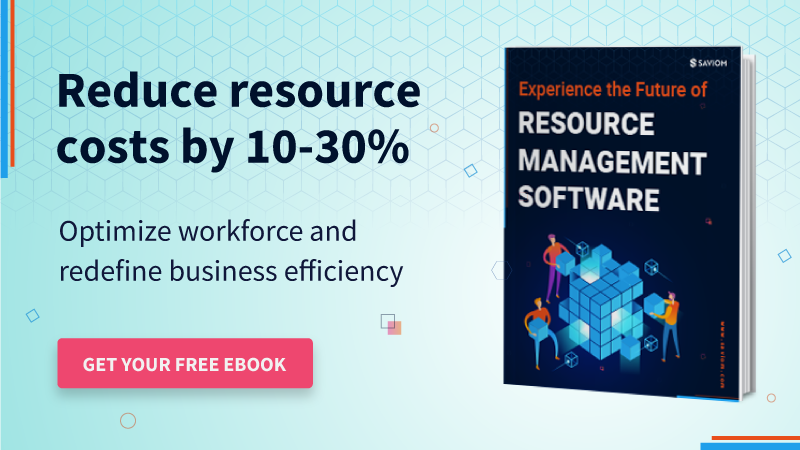“Your workforce is your most valuable asset. The knowledge and skills they represent is the fuel that drives the engine of your business.”
By Harvey Mackay, New York Times best-selling author.
The statement above rightly highlights the vital role that the workforce plays in driving business success. A skilled workforce offers enhanced productivity, advanced problem-solving abilities, consistent performance, and better output quality.
Despite the numerous benefits, organizations spend little to no effort improving their workforce management strategies. The absence of effective workforce planning can create operational and strategic bottlenecks that derail business sustainability. These bottlenecks include skill shortage, higher attrition, suboptimal productivity, etc.
Therefore, organizations have to leverage efficient workforce planning to anticipate future resource requirements and ensure that they have a skilled resource pool at their disposal.
This blog will highlight some of the workforce planning challenges and how to resolve them.
Let’s begin.
What are the adverse effects of poor workforce planning?
Efficient workforce planning can help organizations save costs, meet strategic goals, improve operational efficiency, and boost business growth. In contrast, poor workforce planning can have devastating effects on an organization.
Companies need adequate foresight into the skill demands of potential pipeline opportunities to build an optimized workforce. However, neglecting workforce planning makes it challenging to identify and address skills gaps and resource shortages within an organization. In addition, it leads to frequent hiring/firing cycles, which affects the company’s reputation and organizational efficiency.
Apart from this, in the absence of a workforce planning strategy, managers fail to formulate Individual Development Plans (IDP) and multi-skill building opportunities for employees. As a result, employees often work on similar projects, leading to monotony and stagnancy, resulting in disengagement and loss of productivity.
Without an effective workforce plan, Human Resources Department (HRD) finds it difficult to forecast the adequate number of employees and skill levels required for business continuity. Furthermore, workforce planning directly impacts an organization’s financial health. Companies face project delays and budget escalations in the absence of an optimized resource pool, leading to poor client satisfaction. Consequently, it results in missed business opportunities, hampers market reputation, and reduces profitability.
Now that we understand the effects of poor workforce planning, let’s delve into its significant challenges.
Major challenges of workforce planning
Workforce planning is a core business process that allows organizations to gain a competitive advantage within their marketplace. However, it necessitates significant time and financial investment.
Enlisted below are the primary workforce planning challenges that companies face:
Misalignment between workforce strategy and business goals
In an ideal scenario, companies should align their workforce strategy with their overall business objectives. But, most often, there is a disconnect between the two. Generally, business leaders who create short-term and long-term business goals fail to consult HRD to design the best policies for effective talent management and HR policies.
A lack of planning means HR professionals grapple with attracting and retaining skilled resources. In addition, the absence of collaboration prevents HRD from performing organization capability assessments and identifying gaps in current abilities and future workforce needs. Consequently, it impacts the organization’s ability to meet immediate and long-term business priorities.
Read More: 9 Signs You Don’t Have An Effective Workforce Planning Strategy
Lack of visibility into organizational workforce competency matrix
Most companies capture the core competencies and skills of the employees during the hiring process. However, due to a lack of planning strategies, they often fail to track, update, and maintain the competencies of their workforce regularly. Without clear visibility into the competency matrix across the organization, managers have difficulty identifying and allocating the right resources for current and pipeline projects.
Instead, they assign the first-visible resource to project vacancies, who may not always be the best fit employee. This causes increased bench time for underutilized resources and high burnout for overloaded employees. Furthermore, if this situation persists for a long time, it affects overall productivity and causes unplanned attrition.
Difficulty in forecasting & bridging skill gaps in advance
Due to growing market volatility and intense competition, bridging skill gaps between supply and demand is a top priority for business leaders. However, it’s a challenge for organizations to forecast and bridge this gap when there is a lack of visibility into pipeline projects. Without adequate foresight and proper planning, most companies experience a frequent mismatch between resource capacity and demand.
Due to rapid technological advancements, technical abilities have a short life. But organizations cannot adequately predict future skill requirements without workforce planning. As a result, they cannot plan for regular training & upskilling programs, which leads to skill obsolescence. When the workforce is not optimally skilled, companies cannot gain operational efficiency and often lose future business opportunities.
Read More: Importance of skill development in making your workforce future-ready
Inability to address immediate & seasonal project demands
Addressing immediate and future resource demand is critical for organizations to maintain a competitive edge in the market. However, a lack of foresight into pipeline projects and ineffective capacity planning can prevent organizations from anticipating future resource requirements. As a result, managers are forced to recruit sub-par or expensive resources without sufficient lead time to fulfill immediate project demands.
Conversely, these resources are let go when there is a trough in demand. Therefore, it results in frequent hiring and firing cycles. Additionally, the inability to forward plan project demands means that managers hire permanent resources instead of contingent workers to meet seasonal demand, resulting in higher resourcing costs.
Incapable of having the right mix of permanent & contingent workforce
With rising costs, organizations must think critically about creating a cost-effective workforce. A balanced mix of permanent and contingent workforce enables organizations to meet demand volatility and reduce resourcing costs. In addition, it helps organizations with temporary peak demand without incurring permanent administrative overhead.
However, most companies lack the appropriate planning to build and maintain a mix of a permanent and on-demand contingent workforce. As a result, companies hire permanent resources, leading to cost escalations for short-term requirements. This can cause frequent hiring/firing cycles and impact the financial health and business sustainability.
Read More: What is a Contingent Workforce and Why an Organization Needs It
Unable to deliver projects on time & within budget
A lack of visibility into utilization levels of resources can lead to project delays. Most organizations use multiple applications to manage their projects and resources, which creates silos of data. Due to the absence of a centralized platform, managers cannot analyze employees’ performance and identify and remedy over/underutilization on time.
Sub-optimal resource utilization affects the workforce’s productivity and results in stress, burnout, unplanned attrition, and low employee morale. This affects project workflow and quality. Therefore, failure to leverage the workforce optimally causes schedule and budget overruns.
Ineffective employee retention and succession planning strategy
Intense market competition has made it challenging for organizations to attract and retain talent. Creating long-term employee retention and succession planning is key to maintaining an optimized workforce. However, most companies fail to provide adequate career opportunities and fair compensation, which leads to attrition.
High turnover affects profitability and hurts the reputation of the company. In addition, a lack of succession planning can make a company vulnerable to disruptions. When critical resources retire or leave the organization, and there are no appropriate replacements, it impacts the overall workflow and productivity.
Read More: 9 Effective Employee Retention Strategies for Your Workforce
Now that we have discussed workforce planning challenges let’s look at how advanced workforce planning software help resolve them.
How can robust workforce planning software help resolve these challenges?
Maintaining an optimized workforce in a competitive, skill-based economy is challenging for every organization. Businesses must leverage effective workforce planning to maximize the potential of their human capital and gain a competitive edge.
The tool offers 360-degree visibility into various resource metrics such as demand, availability, capacity, allocation, financials, etc. It enables you to plan, schedule, and allocate resources efficiently and effectively.
The tool’s forecasting capabilities can help you predict future workforce requirements and plan for seasonal variations. Additionally, the capacity planning feature can help you identify excess/shortfalls of resources ahead of time. As a result, you can take preemptive course-corrective action to bridge the gap.
Additionally, it offers real-time reports on various resource indicators such as forecast vs actual, availability, utilization heat maps, project vacancy, and people on the bench reports. The forecast financial reports enable you to track financial variances and take remedial steps. Therefore, it can help you reduce resourcing costs and prevent project budget escalations.
Furthermore, the software helps maintain a competency matrix across the organization, enabling you to develop and implement employee retention and succession planning strategies. Therefore, it can help you futureproof your workforce and ensure that you have an optimized resource pool to meet pipeline requirements.
Lastly, the tool enables you to perform advanced scenario-based modeling and simulation with the What-If Analysis feature. Organizations can compare different scenarios and analyze corresponding outcomes. It provides guidelines to engage your workforce in the prioritized projects when there is a resource constraint.
In conclusion, enterprise-grade workforce planning software can help your organization identify your staffing needs, bridge existing skills gaps, ensure effective workforce utilization, and improve profitability.
Read More: What is Workforce Planning, and How to Master it for Business Efficiency?
Final Thoughts
Although workforce planning can be challenging, it’s an integral component that cannot be overlooked. Good workforce management can help organizations improve operational output, reduce resourcing costs, and ensure business sustainability. Business leaders and HR professionals must work cohesively to address critical workforce challenges so the organization can optimally utilize its resources.
The Glossary
Read More: Glossary of Resource Workforce Planning, Scheduling and Management
The SAVIOM Solution
SAVIOM is the market leader in offering the most powerful and configurable solution for managing your enterprise resources effectively and efficiently. With over 20 years of experience, this Australian-based MNC has created its global presence across 50 countries and helped more than 100 customers achieve their business goals. SAVIOM also has highly customizable products for project portfolio management, professional service automation, and workforce planning software based on business requirements.












